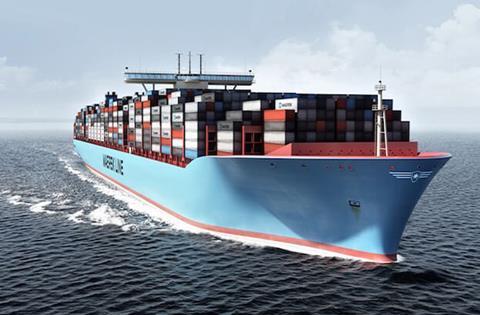Container ship and ro-ro operators have rerouted vessels to avoid danger to crew and cargo in the Red Sea following a number of attacks on ships by Houthi militants in Yemen since October last year.
In response to the latest confirmed incident, which took place on December 30, Denmark’s AP Møller Maersk suspended plans to gradually reintroduce routes through the Red Sea and Suez Canal following an attack on the Maersk Hangzhou, reported to be the 22nd incident since October. Houthi militants launched missiles at the vessel and attempted to board it using four speed boats. That action resulted in US Navy helicopters returning fire on the vessels and sinking three of them with loss of life.

There have since been reports of explosions off the Yemeni coast on January 2. British maritime security firm Ambrey said on January 2 that a Malta-flagged container ship reported seeing three explosions towards its port quarter.
The Houthis are targeting vessels they state are linked to Israel in response to the conflict between that country and Hamas terrorists in Gaza.
Following the attack on Maersk Hangzhou, the Danish government has reiterated its intention to deploy a frigate to the US-led operation to protect cargo ships moving through the area.
Diversions around the Cape
On January 1, Maersk said it was delaying shipments through the Red Sea for 48 hours and published a number of contingency updates to services through the Red Sea and Gulf of Aden. Some services were diverting to the Cape of Good Hope, including all operating on the Europe-Asia Service 6 and a number operating on the Middle East and Transpacific services, while others continued via the Suez Canal. However, in a statement issued on January 2, Maersk said it will pause all transits through the Red Sea/Gulf of Aden until further notice.
“An investigation into the incident is ongoing and we will continue to pause all cargo movement through the area while we further assess the constantly evolving situation,” said the company. “In cases where it makes most sense for our customers, vessels will be rerouted and continue their journey around the Cape of Good Hope.”
Diverting cargo around the Cape of Good Hope is estimated to extend transit times by a minimum of seven to ten days, according to supply chain visibility provider Project44. The disruption has also pushed up ocean spot rates on the Asia to North Europe and Mediterranean trade lanes to levels not seen in more than a year, according to the Journal of Commerce.
Other container vessel operators are rerouting ships to avoid the Red Sea. Taiwan’s Evergreen said vessels en route to Red Sea ports would sail to safe waters and await further notification while it evaluated the situation.
“As for long-haul routes connecting Asia to the Mediterranean, Europe and the east coast of the United States, containerships that are scheduled to pass through the Red Sea will be rerouted around the Cape of Good Hope to continue their voyages to destination ports,” said the company in a statement.
Diverting around the Cape of Good Hope is a tactic that Mediterranean Shipping Line (MSC) has also adopted.
Hapag Lloyd is diverting vessels following a drone attack on one of its vessels on December 15. It said: “According to clause 18 of our bill of lading Matters affecting Performance, we have had to take the decision to avoid the Suez Canal and the Red Sea with immediate effect, and instead route our ships around the Cape of Good Hope.”
OOCL said it is either rerouting or suspending sailing to the Red Sea.
CMA CGM said in December that it had decided to reroute some of its vessels sailing to and from US, to and from North Europe and to and from Asia or Indian subcontinent via the Cape of Good Hope.
“All others CMA CGM containerships in the area that are scheduled to pass through the Red Sea have already been instructed to reach safe areas and pause their journey until further notice,” said the company.
Car carrier commitments
Operators of pure car and truck carriers (PCTCs) are also diverting vessels. Ocean Network Express (ONE), which includes Japan’s Mitsui OSK Lines, Nippon Yusen (NYK), and Kawasaki Kisen Kaisha (Kline), is diverting vessels, including container ships and PCTCS.
On December 19 ONE said that it was immediately rerouting vessels away from the Suez Canal and Red Sea as a temporary safety measure.
“Instead, we will either navigate our vessels around the Cape of Good Hope or temporarily pause their journey and reposition them in a safe location,” said the group in a statement. “We will continue to closely monitor the situation and reinstate our services through the Suez Canal when we determine the area is safe and secure for our seafarers, our vessels, and the cargo onboard.”
On November 19 the NYK-chartered car carrier, Galaxy Leader, was hijacked by armed Houthi militants in the Red Sea while travelling between Turkey and India. At that point NYK set up a crisis management centre at its head office in Tokyo, Japan to gather information and manage the incident. NYK said its priority is the safety of its 25 crew members.
Meanwhile, Wallenius Wilhelmsen said it is rerouting all vessels planned for Red Sea transit via the Cape of Good Hope until further notice.
“Several vessels due to transit the Red Sea have been successfully diverted, and Wallenius Wilhelmsen now has no vessels in or on the way to the area,” said the company is a statement. “We anticipate that rerouting vessels around the Cape of Good Hope will typically add an estimated 10-14 days’ extra sailing time.”
The disruption to services through the Red Sea is an added burden for operators of car carriers vessels at a time when capacity is tight and faster vessel turnaround is a focus. That has meant that some operators continue to transit through the area, including Höegh Autoliners and MOL Auto Carrier Express, amongst others.


























![Global[1]](https://d3n5uof8vony13.cloudfront.net/Pictures/web/a/d/s/global1_726550.svgz)













No comments yet